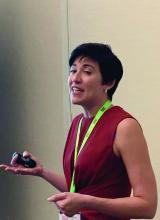FORT LAUDERDALE, FLA. — Researchers have developed an assay that can be used in noninvasive prenatal testing (NIPT) of cell-free fetal DNA present in maternal blood to identify sickle cell disease without using paternal DNA, which could provide an alternative to other invasive methods, according to results of a pilot study.
The novel NIPT assay had a sensitivity greater than 98% and a specificity greater than 99% in early-phase analysis, Vivien A. Sheehan, MD, PhD, of Baylor College of Medicine, Houston, reported at the annual meeting of the Foundation for Sickle Cell Disease Research.
“Noninvasive prenatal testing is a safe and affordable alternative to chorionic villus sampling or amniocentesis and can be performed earlier in pregnancy,” Dr. Sheehan said. “There is a lot of potential for the growth of this test and its impact not only in this country, but worldwide.”
The NIPT uses cell-free fetal DNA from the pregnant mother’s peripheral blood.
“We know that fetal DNA is present in maternal blood and can comprise about 10% by the 10th week of gestation, and it increases as pregnancy progresses,” Dr. Sheehan said.
Maternal alleles from the baby and mother, as well as paternal alleles from the baby, can be identified in maternal blood. “By analyzing cell-free DNA in maternal blood via next-generation sequencing, we can determine fetal disease status,” she said.
Dr. Sheehan noted some reports have supported the use of NIPT for identifying trisomy and aneuploidy, but NIPT has encountered some challenges in identifying autosomal recessive disorders such as sickle cell disease.
To accomplish this, researchers at Baylor and test developer BillionToOne, developed a novel sequencing-based molecular counting strategy that can help measure the ratio of mutant versus normal alleles, Dr. Sheehan said.
The results obtained to date indicate that the assay reliably detects fetal sickle cell disease status when the fetal fraction is as low as 5%, the same limit as aneuploidy NIPT.
The method uses a commercial DNA extraction kit to isolate and purify cell-free fetal DNA from a single blood draw, then performs sickle cell disease NIPT assays using proprietary reagents, Dr. Sheehan explained. The protocol includes bioinformatic analyses that are used to determine hemoglobin S (HbS) mutation ratio and fetal disease status.
The pilot study had two phases. In the first phase, which has been completed, researchers sought to optimize the beta-globin gene probes using cell-free fetal DNA from compound heterozygote patients with sickle cell disease to establish the expected ratio of HbS mutation.
In the second phase, the researchers validated the test on pregnant women with sickle cell trait or sickle cell disease by performing the assay in maternal samples collected between 10-35 weeks of gestation.
Among the six controls who have sickle cell trait, the NIPT reported no false positives when compared with the state newborn screen results, Dr. Sheehan said. For the one participant with sickle cell anemia, the NIPT and newborn screening concurred on two blood draws, but the NIPT was inconclusive on the first blood draw obtained at 10 weeks’ gestation because of low levels of cell-free fetal DNA.
Overall, the analysis showed an analytical sensitivity greater than 98% and a specificity greater than 99%, even in the absence of paternal DNA, the study found.
BillionToOne developed the test. Dr. Sheehan reported having no financial relationships to disclose.
SOURCE: Sheehan VA et al. FSCDR 2019, Abstract JSCDH-D-19-00048.

